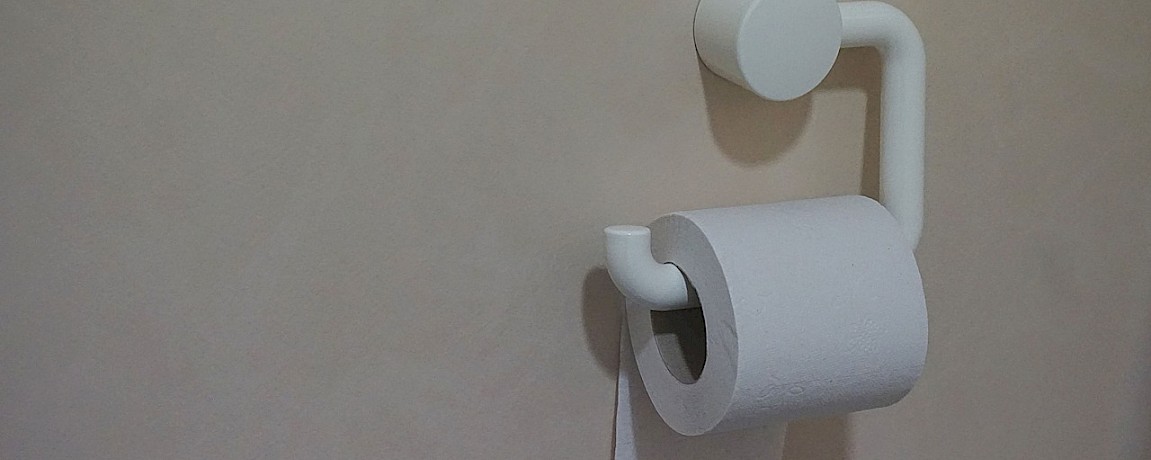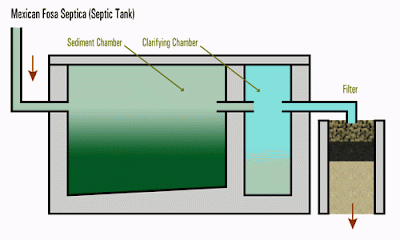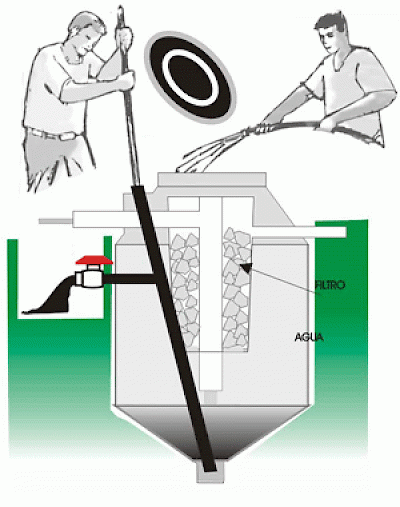Mexican Septic Systems
We promised to explain why you should not put paper in a Mexican toilet, and we’re not going to let you down. There are actually several answers to this question and the most puzzling of these is: you can put paper in a Mexican toilet! Yes, you can. The toilet will not spit the paper back out like a wrinkled dollar from a vending machine. The toilet police won’t show up at your door. And there will be no immediate ill effect from your indiscretion.
But it would be rude.
In many tourist destinations in Mexico, especially hotels, where modern sewage treatment is available, you are encouraged to flush your paper, just like in Gringolandia. The hotel management may even post little signs to let their Mexican guests know that they are expected to dispose of their papel confort down the toilet. They have to do this because Mexicans are trained from birth to be very polite.
But away from the tourist hangouts, and especially in private homes, you will encounter a small, covered, plastic or plastic-lined wastebasket near the toilet. If you see one, then be a polite guest and put your paper in there, not down the toilet.
To understand what etiquette has to do with how you dispose of toilet paper in Mexico, we need a basic understanding of sewer systems. If you are reading this from your home or office in Gringolandia, chances are that your toilet (and anything else that drains from your house) is connected to your city’s public sewer system. Everything you flush flows through large concrete pipes to an industrial processing plant where the solids are separated from the liquids. The liquids are filtered and treated with chemicals and the result is released back into the environment in the least offensive way possible where nature finishes the process using evaporation and rain. The solids are also treated and refined, resulting either in trash or fertilizer. This immense infrastructure is quite expensive to install, operate and maintain. It also consumes a lot of energy. These are your tax dollars at work.
Gringos who flush outside the city limits use a private septic tank, called a fosa septica (septic pit) or sumidero (drain) here in Mexico. In Gringolandia, a septic tank is usually made of a durable plastic and has two chambers, each with a pipe tee inside. The first is the sediment chamber, where the wastewater initially enters. User Plawerth explains the process neatly in his comment:
When waste enters the tank, the paper, poo, and any oils from bathing will float near the surface as a layer known as scum. Over time bacteria will consume nutrients in the scum, and it then settles on the bottom as dense sludge, which is basically inert compost.
When liquid enters the tank, an equal amount of liquid flows out the drain pipe. The tee with its long tube extending down below the surface prevents the floating scum from leaving the tank. The upper part of the tee allows methane and other gases to vent out, while preventing soap foam and lightweight scum above the water line from leaving the tank.
Some scum can still potentially pass, though, which is why there is almost always at least two chambers, and sometimes three chambers, each with a tee on the liquid outlet to restrict scum from leaving the chamber. Usually the first chamber contains most of the sludge and the second and third chambers contain little or no sludge.
If the tank is not cleaned of sludge often enough, eventually it will fill with sludge in all chambers, and then solids will start to leave the tank and plug up the leach field.
A filter on the final outlet will help keep solids that are overflowing out from a poorly maintained septic tank from reaching the drain field, but this needs to be a fine mesh plastic screen or a layer of sand, not just a pile of large loose rocks.
Unlike their northern neighbors, almost all Mexicans use a fosa septica, which is not much different than a Gringolandia septic tank. This technology is very old, so the process is the same. The only difference is the materials. Here in Mexico, many of the colonial houses and other buildings were constructed before the advent of plastics, so most fosa septica are built from plastered stone or concrete block. While plastic septic tanks have one or more manhole covers to permit inspection and cleaning, Mexican fosa septica are generally covered with a slab of concrete and sealed with plaster, like a tomb.
The important difference between a traditional, Mexican fosa septica and a plastic, Gringolandia septic tank is what happens when the clarified liquid is released back into the environment. In the plastic version, the liquid enters one or more perforated PVC pipes, which are buried in long trenches about four feet deep, filled halfway with gravel and covered with topsoil. This is called a drain field, and it’s where you want to plant your strawberries.
In the traditional, Mexican version, the liquid flows down into a filtro (filter), which is a concrete-lined pozo (well) filled with several inches of gravel on top, followed by several inches of charcoal in the middle, followed by a foot or two of sand at the bottom. Why use a filtro and not a drain field? One reason is because the filtro does not use plastics. Another is that this method takes up less space, which is a requirement in colonial urban zones.
But the filtro is the hurdle, so to speak, on the toilet paper trail. Even if much of the paper discarded in a Mexican toilet remains in the fosa septica’s sediment chamber, tiny bits do float past the clarifying chamber and into the filtro, so that over time a paper mache sludge builds up.
How much time does it take to clog a filtro? Nobody knows. It depends on how big the fosa septica and filtro are, how many people are using the toiliet and how much paper or other non-biodegradable stuff they’re flushing down there. It could take three years, or five, or ten. If you don’t flush any paper, it could take fifty or more.
As you probably know, all septic tank systems eventually fill up with sludge and non-biodegradable stuff and have to be pumped out. In Gringolandia, where most septic tanks are located under a lawn in the yard, this is not such a big deal: just dig for a few minutes, screw off the lid and pump away.
In Mexico, maintenance can be a bit more trouble. Many fosa septica are located under the patio, or they might be under the foundation of your house or even partially under your neighbor’s house, because many of these old colonial homes are the result of subdividing a larger mansion. Even when located in a back yard, the access is limited, which means the workers and their hoses will probably be coming through your front door. What’s more, most fosa septica are as old as the houses. Digging into them, like unearthing an ancient tomb, can be risky, leading to cracks or a complete collapse.
This is where famous Mexican thriftiness meets Mexican toilet training. No matter what their socio-economic station in life, Mexicans stretch their pesos and pretty much everything else. When the convenience of flushing paper down the toilet is at the expense of flushing pesos by cracking open a fosa septica, Mexicans would rather have the pesos. In this sense, it would be as rude to flush paper down your host’s toilet in Mexico as it would be to leave the door open on their refrigerator.
Most new homes and residential developments being built in Mexico today do use plastic septic tanks in their construction. When we were working on the design of our new home, we were offered the choice of a plastic septic tank or the traditional fosa septica. The plastic version, called a Septi-K, is billed as an environment-friendly version. It costs less than a fosa septica and has a cover you can remove to rinse the internal filter. The clarified liquids empty into a leach field or French drain. Every ten to 30 months, depending on use, you have to manually remove the lodo (uh... mud), which you can put in your yard as fertilizer or perhaps share with friends. And you can flush paper into it like a gringo.
Hmmm…
When we visit Gringolandia, we now feel uncomfortable putting paper in the toilet. Is it because sorting recyclables by hand is planet-friendly? Is it because it feels like throwing money down the toilet? Or is it just force of habit? Hard to say. In the end, we chose the traditional fosa septica for our new house.
So now you know what to do when you visit our bathroom and why you are doing it. Thanks to you, we may never have to service our fosa septica. At least in this one small way, we have assimilated into Mexican culture.










Comments
Bob Stidham 17 years ago
I have good news and bad news. I have lived in Mexico since 1989 and have designed and installed several septic systems. I just built a new bodega for my machine shop and will install a traditional/modernized septic system (fosa septica) next week here in Queretaro. The paper that gets thrown into the waste basket is re-cycled, along with sanitary napkins and disposable diapers. That's the good news. What is probably going to be considered bad news...the re-cycled product is a grey or reddish colored paper that is used to package many things, including food. The paper is innexpensive, called papel estrasa. If you buy tacos or tortas or tortillas, chances are that they will be wraped in papel estrasa.
Because I have very little faith in the water purification systems here in Mexico, I filter all the water coming into the house and business with a double filter, the first paper, the second activated charcoal and finally an ultraviolet light. All parts of this system are rated for two years, but we change the filters and lights every year, just to be safe.
Reply
Beryl Gorbman 17 years ago
In the 22 years I've owned my colonial house here, we've always flushed the paper and had no problem. Once it goes down the drain I prefer to remain in denial about what happens to it.
However, we're thinking about putting in a pool and I'm wondering how clean the water from our well, or anyone else's, could possibly be. I understand the original wells in Centro are eight feet deep and most people I've talked to have drilled theirs down anywhere between ten and twenty feet to avoid pumping black water into their pools. But with almost a million people pooping away on a daily basis, I'm sure the black water goes down further than that - someone on this discussion mentioned twenty-eight feet. The pools in town look nice, but are people swimming in shit?
Reply
tacogirl 17 years ago
Great article. Was nice to see detailed explanation as to the flushing paper issue.
This looks like an interesting alternative http://wastewatergardens.com/
There is talk about people wanting to get this system being used here on Ambergris Caye Belize. Not sure where water water gardens stand on the flushing paper issue though.
Reply
Things people can’t believe about my life here « Heather in Paradise 17 years ago
[...] even when it’s #2. I never questioned the “whys†behind this cardinal rule, but fortunately Yucatan Living did the research for me in this article. As gross as this initially was to my US-formed brain, I quickly got used to it and now don’t [...]
Reply
Ken C. 17 years ago
Good information. Good to know before going there, as far as what not to do. Good information to have before going to any foreign country.
Reply
Xcalak Marty 17 years ago
Hi EJ,
I'm not a contractor but I tell 'ya, after building our house down here (90% done), I might as well be. I'll refer you to the excellent CEA website and their recommendations for waste water treatment. A relative of ours has studied, designed and implemented these wetland treatment systems in many states and countries, including Mexico, so he's been a great help.
I'm sure your comment on "provide blue prints ...expect it to be done" will have many of us hysterically rolling on the floor. Sometimes you just can't "get there from here"! No licensing for plumbers or electricians, no building codes, etc. The only hope is to find someone who has been recommended as a good plumber, etc. and keep your fingers crossed! Make sure, at least, to have whatever you build engineered so the builder doesn't have to guess the sizes of beams, amount of rebar, etc. Even then, it can be a struggle to get the builder to follow the plans.
Marty
http://ceakumal.org/catalog_12233.html
Reply
EJ 17 years ago
Hello Marty:
When my husband and I travel up and down the Riviera Maya, we kept wondering how the sewer/septic systems were being managed, you have just confirmed is not being done properly. Are you in the construction business? After much thought we have decided that when we build our house in Yucatan, we will build a septic system similar to what WA state has. Check out this link: http://www.metrokc.gov/health/wastewater/owners/index.htm - What we will do is provide blue prints of what we want and expect it to be done, we also considered building 2 septic systems, one specificaly for the toilets and another for the shower, washing mach. etc.
Working Gringos: Are there any RV Parks in Yucatan or QR? If there are, who does the pumping?
Reply
Xcalak Marty 17 years ago
Interesting. Along the Q Roo coast the limestone is a very poor filter and the effluent with all it's pathogens enters the sea water with the natural tidal ebb and flow and has about destroyed the reef in densely populated areas. Akumal has mandated only "Wetland Treatment" (and maybe composting toilets which are generally high maintenance). That is the system we're going to use north of Xcalak. Basically you create a sealed leech field and allow plants and soil microbes to digest the bad stuff in the liquid that exits the septic tank and discharge pure water into the soil Sizing has to be done properly.
There are a few "approved" environmentally sound septic systems which are bad jokes. One uses a kind of RidX (a version on steroids, so to speak) and another actually uses sliced up plastic coke bottles to "digest" the contents of the tank. What none of these systems consider is that they don't deal at all with the pathogens which is what is killing the reef!
Odors...I have seen numerous "modern" design tanks vented, by design, at the ground level instead of sealed. Of course they stink!
I emailed our architect a diagram of a basic plumbing system in the US but I don't think he or the plumber paid much attention! Simple traps at each fixture (sinks, etc.) with vent(s) up to the roof (preventing the suctioning of the traps) prevent odors from entering the house. Registers, as already mentioned, aren't necessary but clean outs are.
Trying to get them to install this stuff is tough. I'll probably "modify" what I can after they're done!
All tanks need to be pumped eventually. Relatively expensive (I think there's a pumper in Chetumal and charges a few hundred USD to come out here) and I expect even systems that were originally pretty sound are now just a "pass through", unfortunately.
Chemicals (harsh cleaners, etc.) are the biggest problem, not paper unless there are obstructions which, after reading this thread, there seem to be. Guess we'll stick with the paper in the can to be safe!
Reply
Stuffed Tiger 17 years ago
Andy, I totally agree. See my comment earlier.
What you can do is bend your chest over to touch your knees when sitting. Not as good as squatting but has some of the same benefits.
You can use a water bottle for washing.
It is possible to get a water spray attached to the toilet unit too. Some even have them. Also, there are bidets.
There is no reason to use paper like we do. It just wipes the shit around and leaves us a lot more stinky than we imagine. Really, not very clean or sanitary.
Reply
Andy 17 years ago
Hello from SE Asia, here they are just starting to put in sit on toilets with toilet paper.
Traditionally the people here used squat toilets and water to clean their body off.
I know it can be difficult for some to squat but it does help the flow of excrement through the body better than the normal sitting position and later a water hose or water recepticle is used to wash the backside, the left hand is used to gently massage the area clean in the water flow.
Hands must be washed afterwards and you do not use the fingernail area for the wiping.
My point? well no paper down the loo or smelly waste bins.
I like this method and I believe it leaves the body cleaner than the paper wipe method.
Reply
Working Gringos 17 years ago
Christine, you may be wrongly informed. Most if not all toilets here are vented, some not very intelligently. As far as we can tell, that does not contribute to the situation.
Reply
« Back (30 to 41 comments)Next »